Ford (crossing)
A ford is a shallow place with good footing where a river or stream may be crossed by wading, or inside a vehicle getting its wheels wet.[1] A ford may occur naturally or be constructed. Fords may be impassable during high water. A low water crossing is a low bridge that allows crossing over a river or stream when water is low but may be covered by deep water when the river is high.
.jpg) Rawney Ford on the Bothrigg Burn, a tributary of the White Lyne in Cumbria, England. | |
| Ancestor | None |
|---|---|
| Related | None, but akin to causeway |
| Descendant | None, but akin to step-stone bridge |
| Carries | Traffic |
| Span range | Short |
| Material | Usually none (natural, preexisting), but sometimes supplemented with concrete or asphalt for vehicles. |
| Movable | No |
| Design effort | None or low |
| Falsework required | No |

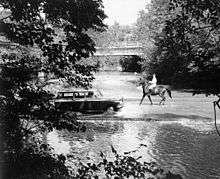
Description
A ford is a much cheaper form of river crossing than a bridge, but it may become impassable after heavy rain or during flood conditions. A ford is therefore normally only suitable for very minor roads (and for paths intended for walkers and horse riders etc.). Most modern fords are usually shallow enough to be crossed by cars and other wheeled or tracked vehicles (a process known as "fording").
In New Zealand, however, fords are a normal part of major roads, including, until 2010, along State Highway 1 on the South Island's east coast.[2] As most inter-city domestic passengers travel by air and as much cargo goes by sea, long distance road traffic is low and fords are thus a practical necessity for crossing seasonal rivers. In dry weather, drivers become aware of a ford by crunching across outwash detritus on the roadway. A bailey bridge may be built off the main line of the road to carry emergency traffic during high water.
At places where the water is shallow enough, but the material on the riverbed will not support heavy vehicles, fords are sometimes improved by building a submerged concrete floor. In such cases a curb (kerb) is often placed on the downstream side to prevent vehicles slipping off, as growth of algae will often make the slab very slippery. Fords may be also equipped with a post indicating the water depth, so that users may know if the water is too deep to attempt to cross. Some have an adjacent footbridge so that pedestrians may cross dryshod.
Watersplash
A road running below the water level of a stream or river is often known as a "watersplash". It is a common name for a ford or stretch of wet road in some areas, and sometimes also used to describe tidal crossings. They have become a common feature in rallying courses. There are enthusiasts who seek out and drive through these water features, recording details (such as wave created, position and access) on dedicated websites.[3]
There are many old fords known as watersplashes in the United Kingdom. Examples are at Brockenhurst in Hampshire, Wookey in Somerset, and Swinbrook in Oxfordshire. Some of these are being replaced by bridges as these are a more reliable form of crossing in adverse weather conditions.
The Dean Ford in Kilmarnock, Ayrshire, is mentioned in the deeds of Dean Castle, which was gifted to the local people. The ford has had to be maintained as a property boundary feature, despite several cars a year being washed away.
Not just a British phenomenon, some very spectacular versions of the watersplash feature can be found in diverse locations. Australia has the Gulf Savannah, and others may be found in Canada, Italy, South Africa, and Finland. They are also found on some Tennessee backroads, where they are referred to as "underwater bridges".
In Israel and part of the British areas under the mandate a low water crossing or watersplash had been known as "Irish bridge"[4] in reference to the Anglo–Irish war.[5][6]
Location names
The names of many towns and villages are derived from the word 'ford'. Examples include Oxford (a ford where oxen crossed the river: see the Oxford coat of arms); Hertford, the county town of Hertfordshire (the ford where harts cross or "deer crossing"); Ammanford (a ford on the River Amman); Staffort crossing the river Pfinz; and Stratford (a ford on a Roman road). Similarly, the German word Furt (as in Frankfurt, the ford of the Franks; Ochsenfurt, synonymous to Oxford; Schweinfurt, a ford where swine crossed the river; and Klagenfurt, literally "ford of complaints") and the Dutch voorde (as in Vilvoorde, Coevorden, Zandvoort, or Amersfoort) are cognates with the same meaning, all deriving from Proto-Indo-European *pértus 'crossing'. This is the source of Brythonic and Gaulish ritus (modern Welsh rhyd; the Welsh name of Oxford is Rhydychen "ford of oxen"), which underlies such names as Chambord (from Gaulish *Camboritum "ford at the bend") and Niort (Novioritum "new ford").
Towns such as Maastricht, Dordrecht, and Utrecht also formed at fords. The endings tricht, drecht, and trecht are derived from the Latin word traiectum, meaning "crossing". Thus the name Utrecht, originally the Roman fort of Traiectum, is derived from "Uut Trecht", meaning "downstream crossing". The Afrikaans form was taken into South African English as drift and led to place names like Rorke's Drift. Similarly, in Slavic languages, the word brod comes from the linguistic root that means "river-crossing" or "place where a river can be crossed". Although today "brod" in the Croatian language means "ship", Slavonski Brod in Croatia, as well as Makedonski Brod in North Macedonia and other place names containing "Brod" in Slavic countries, where "brod" is still the word for ford, are named after fords.
Famous battles
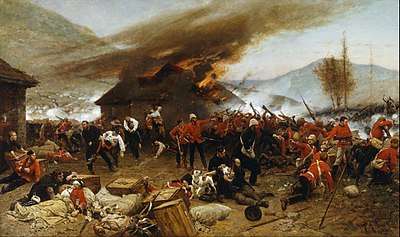
Because in historic times a ford was often a strategic military point, many famous battles were fought at or near fords.
- Battle of Xiaoyao Ford, 215–217, during the wars at the end of the Han dynasty in China
- Battle of Fulford, 1066, on the Ouse River during Harald Hardrada's invasion of England
- Battle of Jacob's Ford, 1179, on the Jordan River during the period between the Second and Third Crusade
- Battle of Imjin River, 1592, on the Imjin River during the Japanese invasion of Korea
- Battle of the Yellow Ford, 1598, on the Blackwater River during the Nine Years' War in Ireland
- Battle of Newburn Ford, 1640, on the Tyne River during the Second Bishops' War in Scotland
- Battle of the Boyne, 1690, on the Boyne River during the Williamite-Jacobite War in Ireland
- Battle of Matson's Ford, 1777, on the Schuylkill River during the Philadelphia campaign of the American Revolutionary War in Pennsylvania
- Battle of Brandywine, 1777, on Brandywine Creek during the Philadelphia campaign of the American Revolutionary War in Pennsylvania
- Battle of Minisink, 1779, on the Delaware River during the Northern theater of the American Revolutionary War in New York
- Battle of Cowan's Ford, 1781, on the Catawba River during the Southern theater of the American Revolutionary War in North Carolina
- Battle of Assaye, 1803, on the Kalina River during the Second Anglo-Maratha War in India
- Battle of Blackburn's Ford, 1861, on Bull Run Creek during the Manassas campaign of the American Civil War in Virginia
- Battle of Kelly's Ford, 1863, on the Rappahannock River during the Eastern Theater of the American Civil War in Virginia
- Battle of Buffington Island, 1863, on the Ohio River during Morgan's Raid in the American Civil War in Ohio and West Virginia
- Battle of Chancellorsville, 1863, on the Rappahannock River during the Eastern Theater of the American Civil War in Virginia
- Battle of Byram's Ford, 1864, on the Blue River during Price's Missouri Expedition in the American Civil War in Missouri
- Battle of Morton's Ford, 1864, on the Rapidan River during the American Civil War in Virginia
- Battle of Rorke's Drift, 1879, on the Buffalo River during the Anglo-Zulu War in South Africa
- Battle of Cut Knife, 1885, on the North Saskatchewan River during the North-West Rebellion in Canada
In fiction
- Achilles Fights the River, Trojan War, as found in The Illiad, by Homer, Book 21, line 1
- The Defence of Duffer's Drift, 1900
- First Battle of the Fords of Isen, February 25, 3019 (Third Age of Middle-earth)
- Second Battle of the Fords of Isen, March 2, 3019 (Third Age of Middle-earth)
Gallery
- The Rye Water Ford in North Ayrshire, a rare unmodernised crossing of a minor river
- A ford along Elko County Route 763 (Rock Springs Road) in rural northeastern Nevada, United States

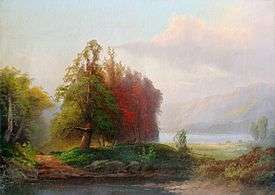 A ford in a 19th-century oil painting. In this instance the ford may have artistic or symbolic significance
A ford in a 19th-century oil painting. In this instance the ford may have artistic or symbolic significance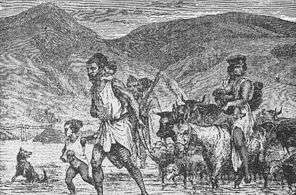 A Berber family crossing a ford in Algeria
A Berber family crossing a ford in Algeria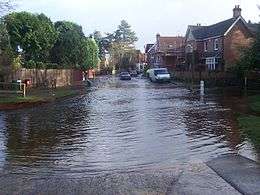 The ford at Brockenhurst, leading into the village centre, following heavy rain
The ford at Brockenhurst, leading into the village centre, following heavy rain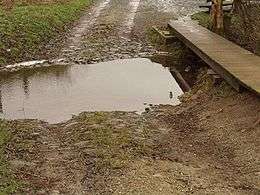 A ford, with pedestrian footbridge, on a minor road near Weimar bei Kassel in Germany
A ford, with pedestrian footbridge, on a minor road near Weimar bei Kassel in Germany Fording an Indian River, c. 1905
Fording an Indian River, c. 1905
See also
References
- Thompson, Della, ed. (1995). The Concise Oxford Dictionary of Current English (Ninth ed.). Oxford. ISBN 978-0-19-861320-6.
- "End of the road for last traffic fords left on State Highway 1". Media statement. NZTA, Christchurch Regional Office. 28 December 2015. Retrieved 29 September 2010.
- "An online guide to every UK ford, watersplash and tidal road". wetroads.co.uk. Retrieved 2011-09-23.
- The Be'er sheva ford was officially called Irish bridge
- Yehuda Ziv - מורשת דרך- the sources of the "Irish bridges"
- explanations about the source of the term Irish bridge
- Stanhope Ford's permanent closure approved, BBC News, 21 February 2012
